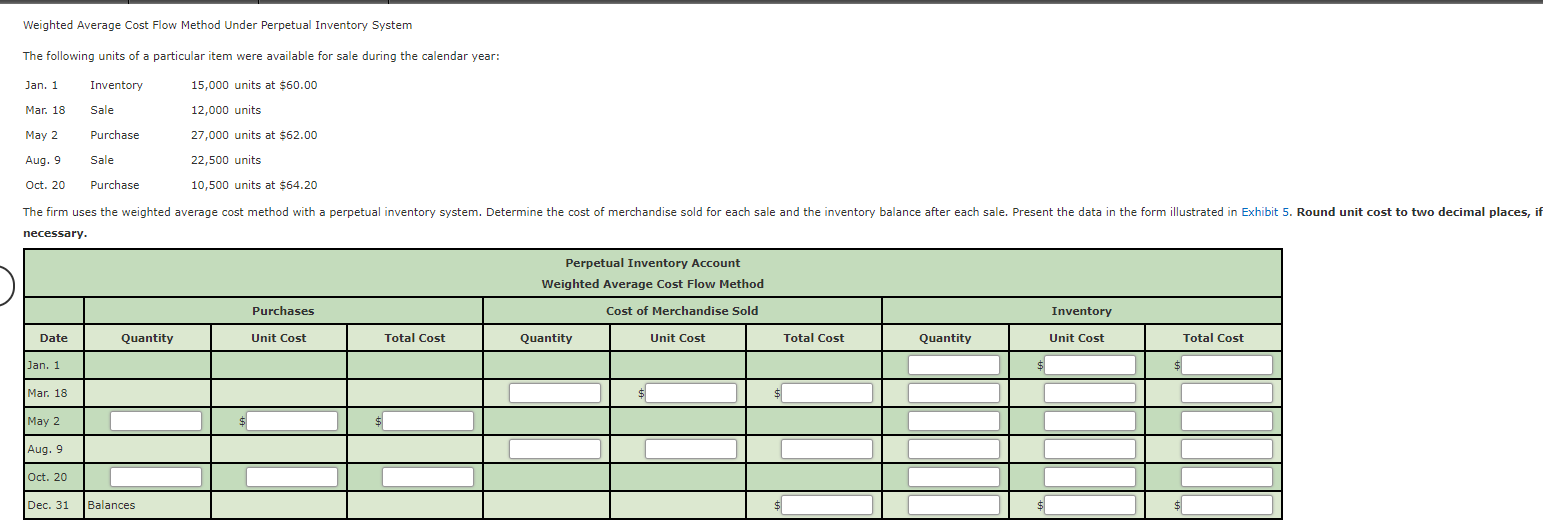
Consequently, a perpetual inventory system is more complex as it has more transactions to process. You assign a unique tracking code, such as a barcode or RFID (radio-frequency identification) code, to every product so that you can track its quantity, location and any other relevant details. The Weighted Average Cost (WAC) perpetual inventory method is a cost flow assumption that uses the average cost of goods sold for all the inventory. With real-time updates, inventory holding costs and inventory replenishments are controlled and minimized.
Which of these is most important for your financial advisor to have?
Many companies counter this with periodic partial inventory counts, which provide a baseline for the perpetual system and are designed to provide a full physical inventory by the end of the period. The balance in inventory account at the end of an accounting period shows the cost of inventory in irs announces e hand. The accuracy of this balance is periodically assured by a physical count – usually once a year. If a difference is found between the balance in inventory account and the physical count, it is corrected by making a suitable journal entry (illustrated by journal entry number 6 given below).
What Is the Periodic Inventory System?
For instance, grocery stores or pharmacies tend to use perpetual inventory systems. A business should use a perpetual inventory system when it needs to have a detailed knowledge of exactly how many units are in stock at all times. It is especially important when the inventory investment is large and when there are many product types in stock. Without a perpetual system, a business would not be able to accurately tell its customers exactly when it can fulfill their orders. It is also a useful system for businesses that are growing rapidly, since these organizations need to maintain tight control over their working capital investments. In addition, any business that has committed to the rapid fulfillment of customer orders needs to have a detailed knowledge of its inventory balances, which only a perpetual system can provide.
Inventory Management
- With a perpetual inventory system, COGS is updated constantly instead of periodically with the alternative physical inventory.
- For example, sales for your holiday-themed candle increase rapidly in Q4, just as you predicted.
- Perpetual inventory is computerized, using point-of-sale and enterprise asset management systems, while periodic inventory involves a physical count at various periods of time.
- Inventory can make up a large part of your stated assets, so integrating inventory management with financial systems helps ensure accurate tax and regulatory reporting.
- The 3 cost flow assumptions are FIFO, LIFO, and the Weighted Average Cost (WAC).
- In this system, every time a transaction takes place, software records a change in inventory levels in real-time.
This is especially important if certain financial records have to be kept for banks and other lenders. You must choose between a periodic inventory system and a perpetual inventory system. Select the best approach for your business, and then research to support your choice.

With a perpetual inventory system, it is no longer necessary to continually conduct physical inventory counts. This is a major advantage, since any physical count requires a business to shut down its warehousing operations for the duration of the count. When a company sells products in a perpetual inventory system, the expense account increases and grows the cost of goods sold (COGS). This includes the materials and labor costs but not distribution or sales expenses.
The Cost ofGoods Sold is reported on the Income Statement under the perpetualinventory method. Moreover, the perpetual inventory system affects the income statement through its impact on the cost of goods sold. By maintaining up-to-date inventory records, businesses can accurately calculate the cost of goods sold, which directly influences gross profit and net income. This accuracy is advantageous in industries with fluctuating costs, as it ensures that financial statements reflect true economic conditions. Additionally, improved inventory management can lead to better cash flow management, as companies are less likely to tie up capital in excess inventory, freeing up resources for other investments. The proper maintenance of a perpetual inventory system requires that a large number of transactions be recorded in real time.
You also make the occasional B2B sale to other retailers that stock your shoes. Get Accounting, CRM & Payroll in one integrated package with Deskera All-in-One. The infrastructure needed to implement this strategy accurately is substantial. Salespeople can manage expectations and deliver a better customer experience. A financial professional will offer guidance based on the information provided and offer a no-obligation call to better understand your situation.
With a perpetual system, inventory data is continuously updated, which helps reduce human errors that can occur during manual inventory counts. This improves the overall accuracy of your inventory records, which is essential for effective decision-making. Plus, it lowers inventory management costs by automatically calculating stock holding costs, replenishing low-stock items and saving labour on manual stock counts.
With a high degree of record accuracy, inventory reordering can be conducted with confidence. Also, it means that a business can reliably promise firm delivery dates to its customers, which enhances customer satisfaction and may even increase sales. Fabrikatör offers advanced inventory management solutions tailored to ecommerce businesses. Our platform supports perpetual inventory management, inventory planning, and real-time tracking, helping you streamline your operations and maintain optimal stock levels.
The result dictates the optimal amount of stock to buy or manufacture to minimise expenses. The Cost of Goods Sold (COGS) formula considers the direct expenses of producing goods. These expenses include the cost of labour and materials and direct factory overhead costs, but not distribution or sales.



Kommentare von reda